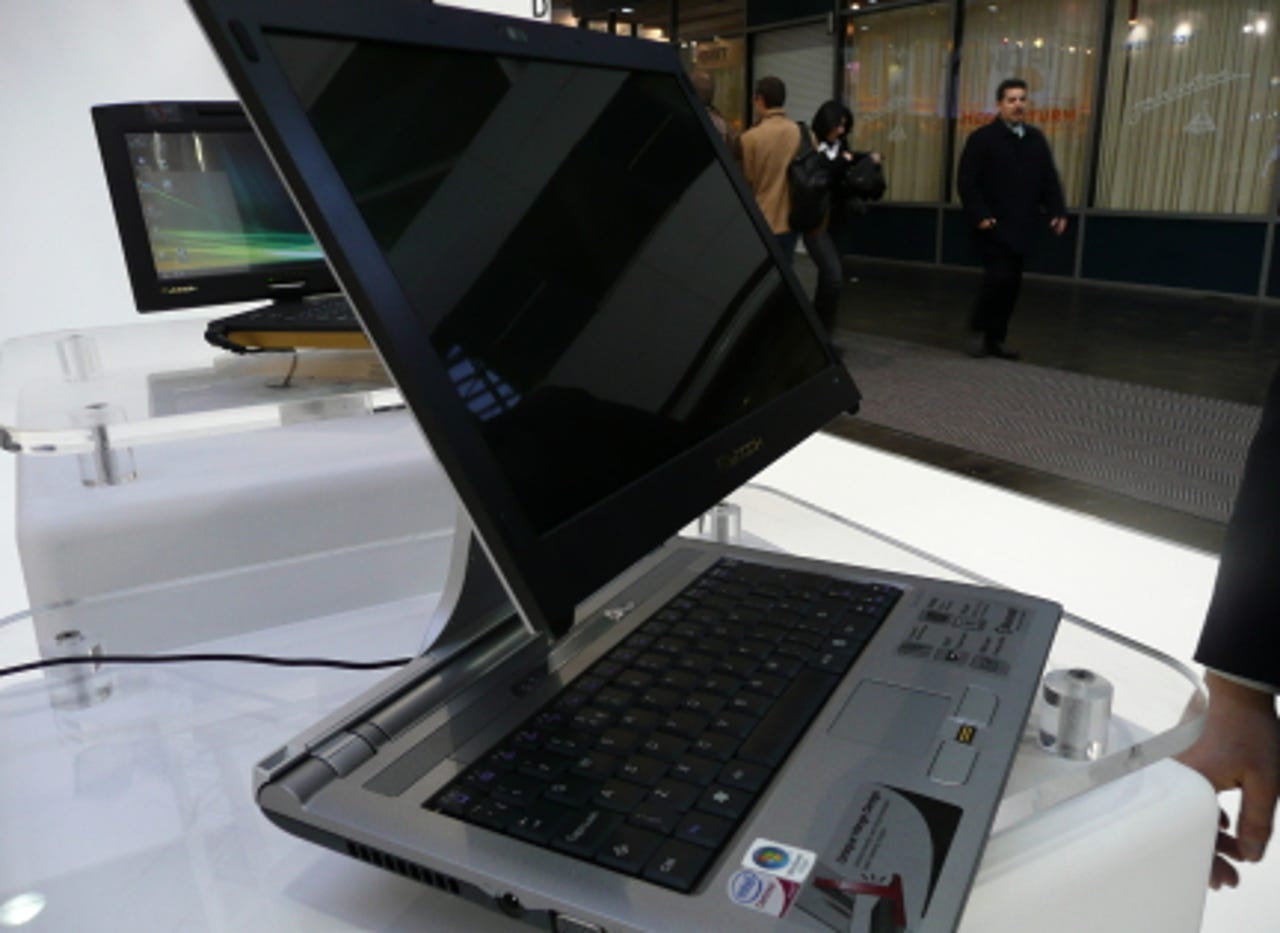Photos from CeBit: Ultimate road warrior tech


This is one for the economy flyer. The Flybook VM is, says manufacturer Dialogue Technology Corp, the first laptop designed specifically for air travel. Dialogue chief executive Roland Pinto said they designed the screen's hinge to allow the whole screen to move forward when the person in front tips their seat back. The slender of wrist can type with their hands below the screen.
Photos and text from ZDNet UK.
At a little over £200, the original version is cheap enough to be bought on expenses, though the price of the new version with the nine-inch screen brings it into the realm of cheap laptops with larger screens. Due to the lower price, we'd still rate the original Eee PC as the ultimate tech at CeBIT for the road warrior wanting a simple, rugged and, above all, cheap laptop.
For those long flights to CeBIT, this General Mobile G777 phone could come in handy. It has fairly standard features for the most part, with GPRS support and 3-megapixel camera. The notable exception is the headset to the left in the picture below, which makes this phone the device to take on longhaul flights, particularly if your company policy dictates that you travel in economy.
A Micro CD card slot means full-length movies can be watched in total privacy on a plane; the example on the stand was showing The Hills Have Eyes II.
The headset contains two tiny screens with a lens arrangement that projects a image of the phone's QVQA screen onto the retina of each eye. While there's nothing new about such headsets--they have been around for at least a decade in one form or another--it is novel to find one attached to a phone.
The Eee PC is fine as a cheap laptop you can throw in a bag, but if you want a rugged laptop with more features for only a slight weight penalty (and admittedly a higher price penalty), the Panasonic Toughbook Executive CF-T7 may be up your street. It has an Intel Core 2 Duo processor and 12.1-inch touchscreen display with an XGA resolution.
If you're really going offroad, this Panasonic UMPC, due to be launched in April, could be the answer. It is based on the Intel Atom processor and comes with Windows XP or Vista.
This General Mobile GM500 Watch comes with a Bluetooth headset and 1.5-inch touchscreen display. It supports GPRS, has a USB port which is also used for charging, and has a claimed talk time of 120 minutes, with 80 hours of standby time.
If you need more a lot of computing power on the road--perhaps for fast deployment to crisis areas--the ultimate power/portability combination is Sun's Blackbox data-centre-in-a-shipping container. At €500k (£343k) without the servers, cooling and switches and so on, it is also significantly cheaper than a bricks-and-mortar data centre. Sun is also offering short-term leases of the box.
Sun claims that the facility is 20 percent more energy efficient than a standard data center and takes a tenth of the time to deploy, but it still requires a decent power source.
A box with 600Amps running through it requires good cooling--that's what the pipes below are for, and they help keep anything up to 500CPUs running in ambient outside temperatures that can range from -22ºC to 55ºC.
The data centre is fitted with standard 19-inch racks, which Sun claims can be more tightly packed than is possible in a traditional data center. A slider mechanism allows the racks to be pulled into the extremely narrow service aisle.
The ultimate road warrior should never have to drive themselves--far better to have the car do it for you. Caroline, the Volkwagen Passat from the Technische Universitat Braunswchweig that drove itself in the Darpa challenge is headed in the right direction. Its seven Debian-based PCs in the boot gather environmental information from the GPS, vision, radar and other assorted sensors, make decisions based on what they "see," and drive the car around complex routes.
Caroline may not have quite completed the Darpa challenge, but it managed a respectable seventh place, and the designers hope to have a version capable of navigating the streets of Brunswick, Germany, within two years. You don't have to touch the steering wheel or gear stick, leaving your hands free to work as you travel, and there's not even any need to press pedals--though the big red "stop" button in the footwell may come in handy.